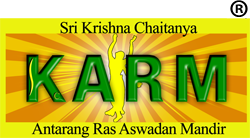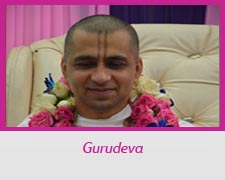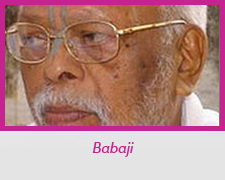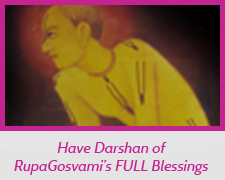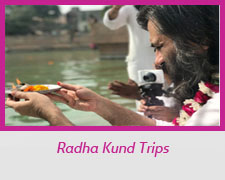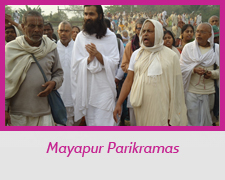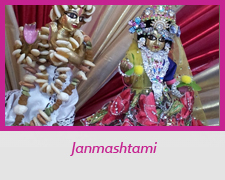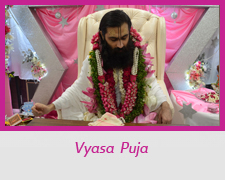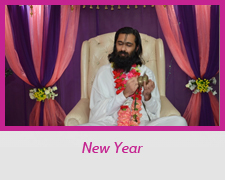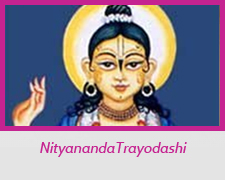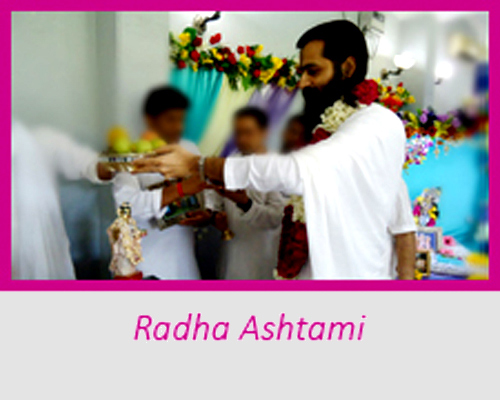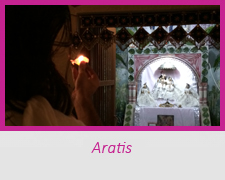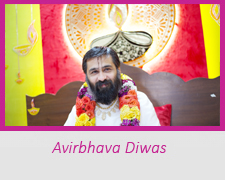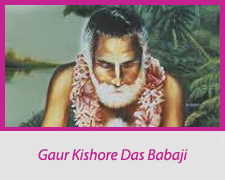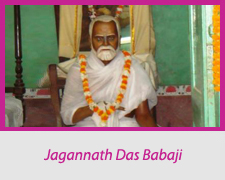With lust, anger, greed, etc…anarthas… can one do Rägänugä Bhakti?!?
Question - MAHÄRÄJA JÉ, Çyämasundara däsa from Sweden is asking if we have anarthas, can we still do Bhakti? Çyämasundara däsa from Sweden is asking this question, can you please elaborate on this MAHÄRÄJA JÉ?
MAHÄRÄJA JÉ - Question is if we have lust, anger, greed inside our heart, if we have anarthas, can we do bhakti or not? This is the question.
Well, Caitanya Caritämåta, our saviour, this Grantha gives the answer… clarity, about whether we can do Ragänugä Bhakti or not, if we have anarthas.
Caitanya Caritämåta tells –
ei ta sadhana-bhakti – dui ta’prakära
eka ‘vaidhé bhakti’, ‘rägänugä-bhakti’ ära
(Caitanya Caritämåta Madhya 22.108)
It is telling, sadhana-bhakti – dui ta’prakära, sädhana bhakti is of two types – one is Vaidhi Bhakti, another is Ragänugä Bhakti.
In simplest of words, Sädhanä or bhakti is of two types. One is Vaidhi Bhakti, another is Ragänugä Bhakti. And please understand, once and for all, that Sädhanä is for Sädhaka. Sädhaka means one who has got käma, krodha, lobha, all the anarthas and he wants to do Bhagavat präpti. He wants to attain the service of the Lotusfeet of the Lord. So, any form of Bhakti, whether it is bhakti of Lord Räma, Lord Narasiàha, Lord Kåñëa, Lord Gaura, any form of bhakti, any devotee is doing, that person will always have anarthas.
And, be very clear, Ragänugä Bhakti is not spontaneous bhakti. Hundreds, thousands and millions of devotees all over the world, no matter what form of bhakti they are doing, no matter in what universe they are doing, no matter on what planet they are doing, they all will have anarthas till they get perfection, Prema. Before getting Prema, no matter what form of bhakti you are doing, you will have anarthas, 100% sure. No doubt about it. It is not that only you have anarthas, everyone has got anarthas. Even Indra Deva has got anarthas.
Gradually all devotees, whether they are devotees of Lord Räma, or Lord Narasiàha Deva, or Çré Kåñëa, all devotees gradually, they start… ädau çraddhä, and then niñöhä, then ruci, then äsakti, then bhäva and then Prema… After anartha Nivåtti, all this niñöhä etc. all the devotees cross through all these stages.
See this is the Grantha, Be a Gauòéya Vaiñëava, and the page no. 199.. stairs we have shown, vaidhi bhakti, däsya bhakti, sakhya bhakti… the stairs are all the same. Anartha Nivåtti is there, then Niñöhä, then Ruci, then Äsakti, then Bhäva, then Prema.Whether you are a Räma Bhakta you will have to cross all the stages, whether you are a Kåñëa bhakta, whether you are any devotee.. any.. Näräyaëa bhakta… or any form of… Any devotee of any sort, in any universe, you will have to go through these stages.
And don’t think, only after anartha nivåtti, I can do a particular form of bhakti. No matter what form of bhakti you do, you all will have to go through all the stages.
This is what Caitanya Caritämåta… I said- saviour is Caitanya Caritämåta… Remember the word ‘saviour’. Why did I say ‘saviour’? Because it is said, sadhana-bhakti – dui ta’prakära, Sädhanä means who has got anarthas. Kåñëa Däsa Kaviräja is telling, with anarthas you can do two forms of bhakti, one is Vaidhi Bhakti and another is Ragänugä. Sädhaka means one who has got anarthas. And Kåñëa Däsa Kaviräja is telling, though you have anarthas, you can do both forms of bhakti. Vaidhi bhakti & Ragänugä bhakti.
It is absolutely wrong to think that only after anartha nivåtti, only after käma, krodha, lobha is finished I can do ragänugä bhakti. This is one thing.
First of all, with anarthas one can do ragänugä bhakti and vaidhi bhakti, this Kåñëa Däsa Kaviräja is telling, sadhana-bhakti – dui ta’prakära! Two forms of Sädhanä. He is saying, one can do Sädhanä while having anarthas, one can do ragänugä Sädhanä.
And the question is – is there only one form of ragänugä bhakti or there are many forms of ragänugä bhakti? Please listen and clear this thing for once and for all – all forms of Kåñëa bhakti are ragänugä bhakti. Däsya bhakti of Kåñëa bhakti is also ragänugä bhakti, Sakhya bhäva bhakti of Kåñëa is also ragänugä bhakti, Vätsalya bhäva bhakti of Kåñëa is also Ragänugä bhakti. And Gopé bhäva or Maïjaré bhäva, all are different forms of ragänugä bhakti.
How to understand in plain and simple words, what is the difference between ragänugä bhakti and vaidhi bhakti!? Because we get fearful, we get freezed when we hear this word ragänugä, as if we have heard the name of some monster. What is ragänugä, what is vaidhi? Vaidhi bhakti simply means a devotee who wants to cross over the cycle of birth and death and wants to attain the servitude of any form of the Lord. That is called vaidhi bhakti. Want to cross over birth and death and want to go to the spiritual world when there is no birth, old age, disease and death. This is called vaidhi bhakti.
And what is ragänugä bhakti? Trying to attain the service of the Lord in a specific rasa, whether it is Sakhya rasa, Vätsalya rasa, Gopé bhäva or Maïjaré bhäva, they all are forms of ragänugä bhakti. You don’t have to become fearful the moment you hear about Ragänugä bhakti. ‘It is not for me!’
All forms of Kåñëa Bhakti are Ragänugä bhakti. The only question is, if you want to just be in the spiritual world somehow, as a servant of the Lord, anywhere in the spiritual world… serving Lord Näräyaëa anywhere. Then it is vaidhi bhakti, plain and simple! Keep it very simple. All forms of Kåñëa bhakti were always Ragänugä bhakti, and will always be Ragänugä bhakti.
We have to be very clear in our understanding. See you all devotees, Gauòéya Vaiñëavas who are in Iskcon, some are spending 20–30–40 years, you don’t even know the difference between Vaidhi bhakti and Ragänugä bhakti! I’m here to tell you all these things on the basis of Scriptures. Caitanya Caritämåta’s Antya Lélä 2.76 is telling, aiçvarya-jïäne nä päi vrajendra-kumära. One who is fixed in awe and reverential mood towards the Lord, he can never attain Kåñëa. räga-bhaktye vraje svayaà-bhagaväne päya. Only devotees who practice räga bhakti, attain Kåñëa. So, if you want to attain Kåñëa, you have to do räga bhakti.vidhi-bhaktye pärñada-dehe vaikuëöhete yäya.
Please don’t burden yourself, what is Vidhi, what is Räga…. Vidhi bhakti means just to cross the ocean of birth and death, disease, old age. ‘I want to attain the service of the Supreme Lord as his servant in Vaikuëöha. I do spiritual practices.’ That is called Vaidhi bhakti.
And, räga-bhaktye vraje svayaà-bhagaväne päya. Only by doing räga bhakti one attains Kåñëa. Why is it so? Räga bhakti means desiring to attain Kåñëa in specific rasa. Only if you want to attain Kåñëa in specific rasa, you will attain Kåñëa! Plain and simple!
If you are not very particular in your desire to attain Kåñëa in specific rasa, you will not go to Goloka. Just a form of service, as a servant of the Lord, if you are doing bhakti… birth, old age, disease, death, and ‘the Lord is Supreme, I am his servant.’ That is called Vidhi bhakti.
This is a very beautiful Grantha by Çréla Viçvanätha Cakravarti Öhäkura, Räga Vartma Candrikä, in 2.7, he is telling,
atha rägänugä bhakti – majjanasyänartha nivåtti niñöhä – rucy – äsakty-anantaraà prema – bhümikärüòhasya säkñät sväbhéñöa-präpti – prakäraù pradarçyate
He is telling the details in 2.7, atha rägänugä bhakti – majjanasyänartha, I’m telling you the translation…
First of all, the wrong thing propagated to us was that Ragänugä bhakti is spontaneous bhakti. Well, Ragänugä bhakti is not spontaneous bhakti, Ragänugä spontaneous bhakti is only of Nanda, Yaçodä, Lalitä-Viçäkhä, Rüpa-Rati Maïjarés, Rataraka-Pataraka, those who are eternal associates of the Lord, they only do spontaneous bhakti. Spontaneous… spontaneous love for Kåñëa. Only they do spontaneous bhakti.
ei ta sädhana-bhakti – dui ta’ prakära, the savior Caitanya Caritämåta is coming again. eka ‘vaidhé bhakti’, ‘rägänugä-bhakti’ ära. So, this Viçvanätha Cakravarti päda is telling in 2.7, Räga Vartma Candrikä that, gradually all the Ragänugä bhaktas, in whatever rasa you are…
See, who is telling? Viçvanätha Cakravarti Öhäkura. Not your temple president, not some senior authority. Çréla ViçvanäthaCakravarti Öhäkura!! Who is always right, he is telling, all forms of Ragänugä bhakti, they have to gradually pass these stages of anartha Nivåtti, Niñöhä, Ruci, Äsakti and after that, they get to the stage of prema. Very clearly, he is telling. Niñöhä, Ruci, Äsakti… anantaraà prema – bhümikärüòhasya. Do you understand this Sanskrit? prema – bhümikärüòhasya … after what?
After anartha Nivåtti, Niñöhä, ruci, äsakti, anantaraà prema – bhümikärüòhasya. So, very clearly, Viçvanätha Cakravarti is telling here, all forms of Ragänugä bhakti are our Sädhanäs. All Sädhakas, all devotees, all of them, no matter you are in Vätsalya rasa, Gopé bhäva, Maïjaré bhäva, even form of Kåñëa’s däsa, you will have to pass through the stage of anartha nivåtti.
Ragänugä bhakti simply means, you want to attain Kåñëa in a particular rasa that is Ragänugä bhakti. And, you just want to attain Lord’s service somehow, some way, that is Vaidhi bhakti. And here, Çréla Viçvanätha Cakravarti Öhäkura is very clearly telling- All Ragänugä bhaktas, prema – bhümikärüòhasya, attain the stage of prema only after anartha nivåtti, ruci, äsakti. Everyone has to pass through these stages. No one is an exception to these…
Ragänugä bhakti is not spontaneous. Spontaneous bhakti is of Lalitä-Viçäkhä. Rüpa-Rati Maïjarés. And we pray the bhakti they have got in their hearts; may we get a drop of that bhakti. We pray for the drop of the ocean of bhakti which they have in their hearts. They have oceanic bhakti, they are spontaneous bhaktas. Not we all Sädhakas.
This is a very wrong logic given. Only after anartha nivåtti you can start rägaunuga bhakti. Are you greater than Viçvanätha Cakravarti Öhäkura, who is very clearly telling all rägänugä bhaktas in all sampradäyas… Not in Gauòéya, he is not telling for Gauòéya Vaiñëava sampradäya. He is telling for all sampradäyas. And, I have heard äcäryas in all sampradäyas. They are quoting this topic from Viçvanätha Cakravarti Öhäkura, I have heard from other devotees also. You have to pass through these stages to attain prema. You want to say, only after anartha nivåtti you can do ragänugä bhakti. It means to become a servant of Lord Näräyaëa, you don’t have to pass through the stage of anartha nivåtti? To become servant of Lord Kåñëa, you have to pass through the stage of anartha nivåtti, but to become servant of Lord Näräyaëa or Lord Räma you don’t have to pass through the stage of anartha nivåtti?
Again, the savior comes, ei ta sädhana-bhakti – dui ta’ prakära. Sädhana bhakti is of two forms. Vaidhi and Ragänugä. Sädhanä means done by Sädhaka, Sädhaka means who will cross through the stages of niñöhä, ruci, äsakti, bhäva, prema.
Whether you want to attain the service of Lord Näräyaëa or whether you want to attain the Däsya of Çré Kåñëa, you have to cross all stages. This is a wrong propagation being done – ‘Ragänugä bhakti means spontaneous bhakti. Ragänugä bhakti is not for us.’
If you are saying Ragänugä bhakti is not for us, you are very clearly saying – Kåñëa bhakti is not for us. Because Ragänugä bhakti means Kåñëa bhakti. Kåñëa bhakti is Ragänugä bhakti. Like ‘päpä’ and ‘father’ they are the same thing nä, or they are something else? ‘Mummä’ and ‘mummé’ – same thing. Similarly, Kåñëa bhakti and Ragänugä bhakti – it is the same thing, synonyms.
Modern institutions are deviating so many innocent devotees, that they are ruining lives of devotees. Let’s assume you want to become sakhä, friend of Kåñëa. So, don’t you have to cross through the stage of anartha nivåtti to become sakhä. Is there any logic? Becoming Kåñëa’s Sakhä is also Ragänugä / räga bhakti. And if you want to make Kåñëa your Laddü Gopäla, still you have to cross the stage of anartha nivåtti. Is this making any sense to anyone? This can make sense only to institutional leaders, fanatic institution, blind institution leaders.
You are qualified to become däsa of Näräyaëa, but you are not qualified to become däsa of Kåñëa, like Rataraka-Pataraka? Wah! All glories to your ignorance.
